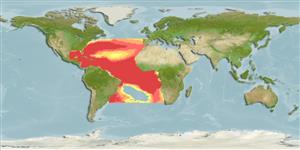Classification / Names
Common names from other countries
Main reference
Size / Weight / Age
Max length : 254 cm FL male/unsexed; (Ref. 40637); common length : 165 cm OT male/unsexed; (Ref. 43); max. published weight: 58.0 kg (Ref. 40637)
Environment
Marine; pelagic-oceanic; oceanodromous (Ref. 51243); depth range 0 - 200 m (Ref. 43), usually 100 - ? m (Ref. 4770)
Climate / Range
Subtropical, preferred 26°C (Ref. 107945); 44°N - 33°S, 98°W - 17°E (Ref. 43)
Distribution
Atlantic Ocean: widely distributed in offshore waters, much more densely so in the western than in the eastern Atlantic. Highly migratory species, Annex I of the 1982 Convention on the Law of the Sea (Ref. 26139).
Countries | FAO areas | Ecosystems | Occurrences | Introductions
Short description
Dorsal
spines
(total): 0;
Dorsal
soft rays
(total): 50-57;
Anal
spines: 0;
Anal
soft rays: 18 - 21;
Vertebrae: 24. Blue-black above, silvery white splattered with brown on the sides, silvery white below; dorsal fins dark blue; pectorals blackish brown, occasionally with tinges of greyish white; pelvic fins blue-black with a black fin membrane; 1st anal fin dark blue with silvery white at base; 2nd anal fin blackish brown.
IUCN Red List Status (Ref. 115185)
Threat to humans
Harmless
Human uses
Fisheries: minor commercial; gamefish: yes
More information
ReferencesAquacultureAquaculture profileStrainsGeneticsAllele frequenciesHeritabilityDiseasesProcessingMass conversion
Tools
Special reports
Download XML
Internet sources
Estimates of some properties based on models
Phylogenetic diversity index
PD50 = 0.5630 many relatives (e.g. carps) 0.5 - 2.0 few relatives (e.g. lungfishes)
Trophic Level
4.4 ±0.4 se; Based on diet studies.
Resilience
Medium, minimum population doubling time 1.4 - 4.4 years (Assuming tm=2-4)
Vulnerability
Moderate to high vulnerability (49 of 100)
Price category
